#devi durgaa
Explore tagged Tumblr posts
Text
youtube
Devi Durgaa - Ayigiri Nandini Stotram | Mahishasura Mardini Stotram - महिषासुर मर्दिनी स्तोत्र | IMM - Insider Meditation Mantra Sleep Music is the perfect relaxing music to help you go to sleep, and enjoy deep sleep. Our music for sleeping is the best music for stress relief, reducing insomnia, and encouraging dreaming. Our calm music for sleeping uses delta waves and soft instrumental music to help you achieve deep relaxation, and fall asleep. Our relaxing sleep music can be used as background music, meditation music, relaxation music, peaceful music, and sleep music. Let the soothing and calming sounds help you enjoy a piece of relaxing deep sleep music. Relaxing Music to Rest the Mind, Stress, Anxiety, Meditation. Insider Meditation Mantra Sleep Music, Study Music, and Focus Music, Relaxing Music, Meditation Music (including Tibetan Music and Shamanic Music), Healing Music, Reiki Music, Zen Music, Spa Music, and Massage Music, Instrumental Music (including Piano Music, Guitar Music, and Flute Music), and Yoga Music. We also produce music videos. For long hours, beautiful relaxation music, meditation piano music, stress reliever piano music, check out our YouTube playlist. Thanks for tuning in to our relaxing sleep music! Introduce yourself to the Insider Meditation Mantra community in the comments section and let us know where in the world you’re listening from. Enjoy! Love.
#devi durgaa#devi durga#ayigiri nandini#durga devi#mahishasura mardini stotram#महिषासुर मर्दिनी स्तोत्र#aigiri nandini song#durga maa#aigiri nandini#aigiri nandini nandita medini#aigiri nandini nandini#aigiri nandini - mahishasurmardini stotra#aigiri nandini nandita medini vishwa vinodini#durga devi stotram#durga stotram#durga devi mantra#aigiri nandini stotram#aigiri nandini mahishasura mardini stotram#shri mahishasura mardini stotram#insider meditation mantra#youtube#vedic mantra#stotram#mantra meditation#mantra#Youtube
0 notes
Text
Avatars of Shakti
Chaitra Navratri: Siddhidatri

On the ninth and last day of Chaita Navratri, Shakti is worshipped in the form of Siddhidatri (Siddhi=perfection, Datri=giver). In iconography, She is depicted with four arms and holds a lotus, conch, gada (mace), and chakra, and She sits on top of a lotus flower. She governs the planetary body Ketu, which is the southern lunar node.
This form of Shakti is worshiped by not only humans but also the other Gods. Her worship by Shiva is mentioned in Scripture, as related by Baba Rampuri:
When the Universal Mother was gripped with the idea of projecting Creation, She, first of all, created Lord Shiva who prayed to Her to endow him with perfections. For this purpose, the Universal Mother (Durgaa) produced Goddess Siddhidaatri from Her own person. As the behest of the Universal Mother, Goddess Siddidaatri bestowed eighteen kinds of rare perfections and powers and potentialities (Siddhis) on Lord Shiva. By virtue of these siddhis, Lord Shiva happened to develop a divine splendor.
Having acquired the siddhis from Goddess Siddhidaatri, Lord Shiva created Lord Vishnu who in turn created Lord Brahma who was entrusted with the task of the Creation whereas Lord Vishnu got the task of Protection and Lord Shiva that of Destruction.
Lord Brahma felt a great difficulty in his task of the Creation in the absence of man and woman. Thereupon he remembered Mother Siddhidaatri. When she appeared before him, Lord Brahma said to her, “Oh Great Mother! I cannot carry on with the task of the Creation in the absence of man and woman. You kindly solve this problem of mine through your supernatural attainments (siddhis).”
Having heard Lord Brahma, Mother Siddidaatri converted half the person of Lord Shiva into a woman. Thus Lord Shiva became half-male and half-female and came to be known as Ardhanaarishwara. Thus the problem of Lord Brahma was resolved and the task of the Creation went on smoothly.
Her mantra is:
Sidhha Gandharvay khshadher Surair Marair Api
Sevya Mana Sada Bhooyat Siddhida Siddhidayini
Which in English means:
Goddess Siddhidatri who is worshipped by Siddha, Gandharva, Yaksh, Gods, Demons etc., holds Conch, Chakra, Gada and Lotus in her hands, giver of all siddhis and victory all over, be propitious to me.
For purposes of pronunciation, I have included a link to the spoken mantra (The mantra itself lasts for the first minute of this video, after which a speaker gives a lecture in Hindi).
Chaitra Navratri: Mahagauri
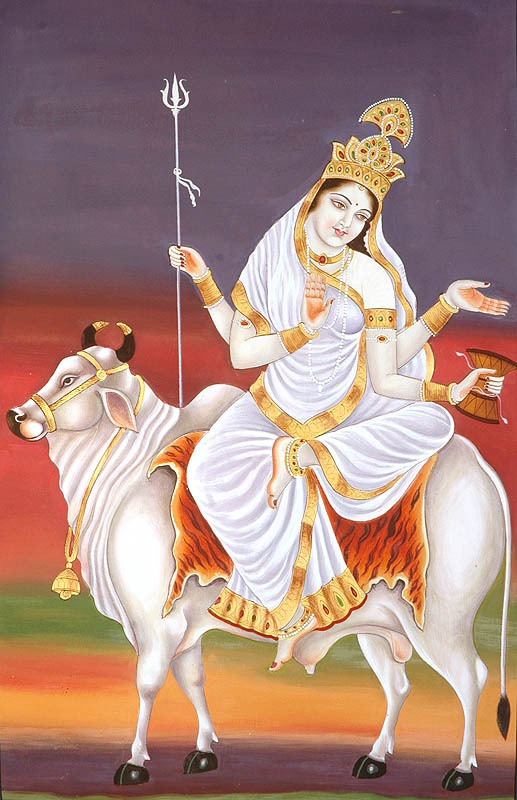
On the eighth day of Chaitra Navratri, Shakti is worshipped in the form of Mahagauri (Mahagauri=extremely white). She has four arms. In Her upper right hand She holds a trishul (trident) and in Her lower left hand She carries a Damaru (small, two-headed drum). Her upper left hand is in the Varada Mudra position, and Her lower right hand forms the Abhaya Mudra. She rides atop a white bull and rules the planetary body Rahu (In Vedic astrology, Rahu is the northern node of the Moon). The following origin of this form in mythology is related by Yogi Ananda Saraswathi:
She observed severe penance as Goddess Parvati to get earn Lord Siva as her husband. Once, Lord Shiva was rude to her by pointing out her dark complexion. She started observing hard penance. This went on for over a thousand years. During this period her body got covered with soil. It became darker than ever. Then one day when Lord Shiva came looking for Mother. He was pleased with her penance. Thereafter he took Maa to the Ganges and bathed her lovingly. Mother regained her beauty with pure complexion and earned the name Maha Gauri.
In this form Mahagauri represents purity and austerity. She scours and scrubs the filth from the souls of Her devotees and purifies their hearts. Both married and unmarried women especially worship Her on this day, as She is said to guide unmarried women in finding a good husband and She blesses married women with peaceful and harmonious marital lives.
Kumari Puja during Ashtami Puja celebrations also occurs on the eighth day of Chaitra Navratri, as related by this passage from astrosage.com:
On the sacred occasion of Ashtami Pooja, Kanya Poojan (feeding of little girls) are also done to please Goddesses of Navdurga (nine forms of Durga). Nine little girls are invited at home of worshippers and are fed varieties of delicious sweet dishes. Devotees pay the best homage to nine little girls considering them nine forms of Navdurga. This ritual accomplishes their Pooja and gives blessings of Nav Durga.
Her mantra is:
Shwete Vrishe Maha Rudha Shwetambardhara Shuchih
Maha Gauri Subham Dadhyanmahadev Pramodada
Which means in English:
Goddess Mahagauri who rides on white bull, wear pure white clothes, giver of happiness, be propitious to me.
For purposes of pronunciation, I have included a link to the spoken mantra (The mantra itself lasts for the first 35 seconds of this video, after which a speaker gives a lecture in Hindi).
Chaitra Navratri: Kalaratri
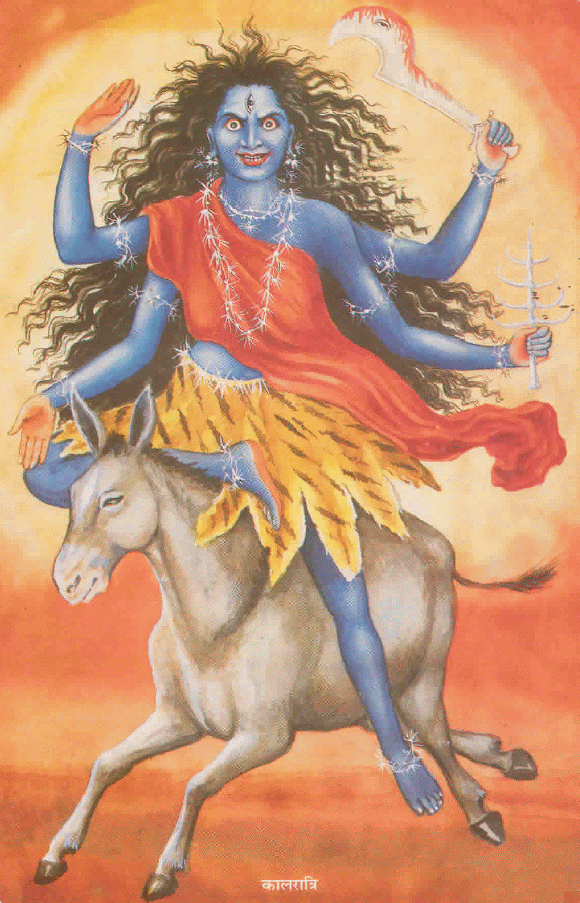
On the seventh day of Chaitra Navratri, Shakti is worshipped in the form of Kalaratri (Kala=time, black in reference to the primal darkness before the Creation, Ratri=night). Kalaratri is a form of Kali. She is dark in complexion and rides atop a donkey. She is depicted with four arms, Her right hands positioned in Abhaya and Varada mudras and Her left hands holding a sickle and a thorn-like iron weapon. In mythology, She slayed the dreadful demon Raktabeej, as Miss Saxena relates:
In this form Goddess Kalratri killed Raktabeej. Raktabeej was a demon who could multiply from every drop of his blood which fell on the ground. The Goddess Kaalratri killed him by licking the blood before it could reach the ground and hence conquered him.
Kalaratri’s form is dreadful and repulsive in appearance (She is the most misunderstood of the Hindu Goddesses by many Westerners!), but She is very protective of Her devotees and protects them against the evil spiritual influences of demons and dark forces. While She has a ferocious side, She also has a very maternal side. She also aids Her devotees to rid their lives of tamasic qualities, effectively destroying ignorance. She governs the planet Saturn and is associated with the Sahasrara (thousand, infinite) chakra, which is located on the crown of the head. It is the chakra of Pure Light and of Supreme Consciousness. Awakening the Sahasrara chakra leads to ultimate spiritual enlightenment.
Her mantra is:
Ekveni Japakarnapura Nagna Kharastitha
Lamboshthi Karnikakarni Tailabhyakta Sharirani
Vaampadolla Salloh Lata Kanthak Bhushna
Vardhan Murdha Dhvaja Krishna Kalratri Bhayankari
Which means in English:
She is naked, rides on an donkey, has a long tongue, lustrous body, wears ornaments on her legs like lightning, is black in color, has unlocked hair, big eyes and ears and is very dangerous looking. Meditating on this form of Kalratri removes all obstacles as well as removes all magical effects created by others.
For purposes of pronunciation, I have included a link to the spoken mantra (The mantra itself lasts for the first minute of this video, after which a speaker gives a lecture in Hindi).
Chaitra Navratri: Katyayani
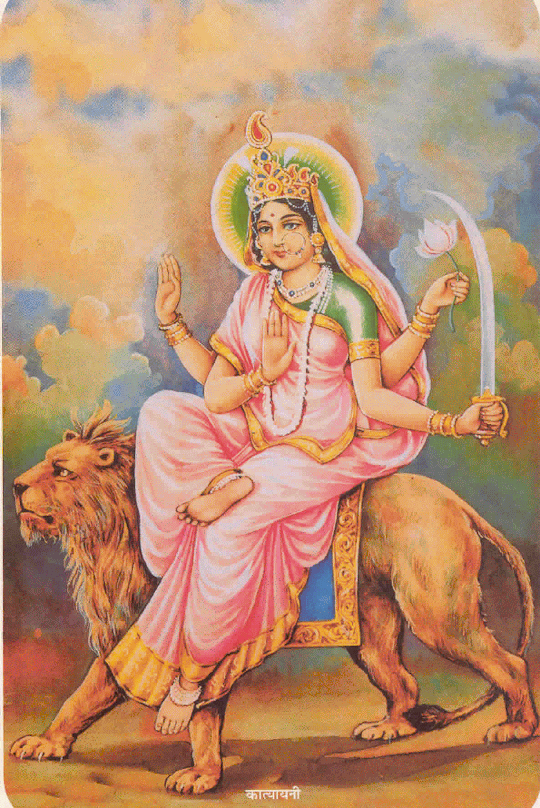
On the sixth day of Chaitra Navratri, Shakti is worshipped in the form of Katyayani. The story behind her name’s origin is related by Mr. Subhamoy Das in the following passage:
The legend behind her name goes thus: Once upon a time, there was a great sage called Kata, who had a son named Katya. Kata was very famous and renowned in the lineage of saints. He underwent long austerities and penance in order to receive the grace of the Mother Goddess. He wished to have a daughter in the form of a goddess. According to his wish and desire the Mother Goddess granted his request. Katyayani was born to Kata as an avatar of Durga.
Katyayani rides atop a majestic lion and is (typically) depicted with four arms. In Her left hands She holds a sword and a lotus flower (symbolising blooming above the murk to achieve enlightenment); Her right hands are positioned in Abhaya( indicates for the devotee not to fear and is a symbol of protection) and Varada (symbolises the giving of blessings) mudras. In the Vamana Purana, She is depicted in Her fiercest form during the battle with the demon Mahishasura, whom She slays.
Katyayani rules over the planet Jupiter. Her chakra is the most important of all chakras: the Ajna (command, knowledge, wisdom) chakra, or Third Eye. This is where the bridge between our human potential crosses into Divine Consciousness. Hindus also believe that spiritual energy from the outside world enters the conscious via this gateway chakra, and so they take great care in protecting this chakra through religious markings (made with holy ash, vermillion, etc.) on the third eye.
a lady’s marriage is experiencing any delays Katyayani is often worshipped in order to remove the obstacles that are preventing the marriage from taking place.
Her mantra is:
Chandrahaasojjval Karaa Shaardoolvarvaahanaa
Katyayani Shubham Dadyaad Devi Daanavghatini
Which in English means:
Devi Katyayani, who holds Chandrahaas Sword and other weapons in her ten hands, rides on Lion, and destroying demons, be propitious to me.
(Note: She is most commonly depicted with four hands, but some Images do depict Her with eight, ten, and even eighteen hands!)
For purposes of pronunciation, I have included a link to the spoken mantra (The mantra itself lasts for the first 35 seconds of this video, after which a speaker gives a lecture in Hindi).
Chaitra Navratri: Kushmanda
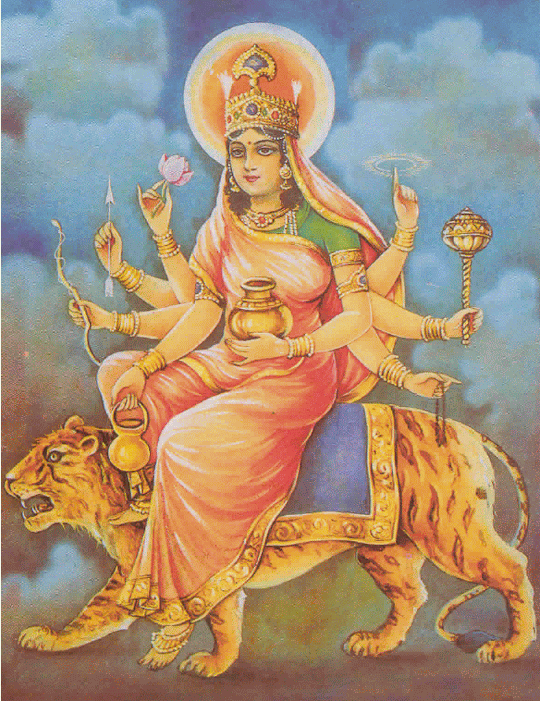
On the fourth day of Chaitra Navratri, Shakti is worshipped in the form of Kushmanda (Ku=little, ushma=warmth, anda=egg). Symbolically, Her name means “that is from whose fraction of warmth the universe has been emanated,” designating Her as the comic egg which created the Universe and hence a Creator Goddess. Parvati takes on the form of Kushmanda after She started living inside the core of the Sun to liberate energy to the rest of the Universe. As a solar Goddess, Her governing planetary body is the Sun. This goes back to Her role as a Creator, for in the beginning the Universe was nothing more but a void of darkness until Her light spread in all directions. Her mount is a lion and She is depicted with eight arms in iconography. She holds a kamandal (an oblong water pot carried by ascetics), dhanush (bow), arrow, and lotus flower (symbolising blooming above the murk to achieve enlightenment) in Her right hands, and in Her left hands She carries a kalasha (a metal pot with a large base and small mouth), Japa mala beads (prayer beads), gada (a blunt mace/club), and a chakra (a disc-like weapon). Kushmanda bestows brightness, clarity, and peace upon Her worshippers.
She is associated with the Anahata Chakra (anahata=unstruck, unhurt in Sanskrit, implying that beneath all the pain in our heart, universal love and compassion is our core nature that is still intact even though we may believe it is damaged), which is the seat of love located in the heart. Love does not only refer to the popular sense of the word, however, but also to the deep, compassionate, Divine love. In a beautiful description of the Anahata chakra, a writer on chakras.net writes:
The Anāhata Chakra is our inner temple in which the divine Ātmā, “the flame of life”, resides. Self-Realisation, also known as God-Realisation, involves the recognition of our own Self, the Ātmā. To show that something belongs to us or concerns us we spontaneously point to the centre of the chest, the site of the Anāhata Chakra. No-one points to the head, the stomach or any other part of the body. This shows clearly that we spontaneously identify ourselves with the Ātmā within the heart centre. In the Chandogya Upanishad it is written:
“In the centre of the body there is a little shrine surrounded by a wall with eleven doors. Hidden within the shrine a Lotus blossoms, and within this there is a tiny, little room.”
What does this tiny room in the heart of the Lotus mean? It is the Ātmā, our true Self. The Ātmā is a part of God. It is pure, unchanging, Infinite Consciousness. It is Eternal, Unborn and Immortal, and exists in every living being. Just as the whole tree is already contained and present within a seed, the essence of the entire cosmos exists in the centre of the Heart Chakra.
Her mantra is:
Sura Sampurna Kalasham Rudhira Plutmev Cha
Dadhana Hastpad Mabhyam Kushmanda Shubh Dastu Me
Which means in English:
May the Goddess Kushmanda who holds two pitchers full of madira and blood in her lotus hands, be propitious to me. (I believe the word ‘madira’ is in reference to amrita, the nectar of immortality. Corrections for the meaning of this mantra, as well as further explanations regarding its meaning, are very welcome!)
For purposes of pronunciation, I have included a link to the spoken mantra (The mantra itself lasts for the first 35 seconds of this video, after which a speaker gives a lecture in Hindi).
7 notes
·
View notes
Text
Devi Mahatmyam Full Tamil With Meaning Pdf

% Text title: devii maahaatmyam / durgaa saptashatii% File name: durga700.itx% itxtitle: devI mAhAtmyam athavA durgAsaptashatI% engtitle: devI mAhAtmyam or durgAsaptashatI% Category: devii, durgA, shatI, devI, saptashatI% Location: docdevii% Sublocation: devii% SubDeity: durgA% Texttype: pramukha% Language: Sanskrit% Subject: religious% Transliterated by: K. Devi Mahatmyam Slokas In Tamil Pdf As part of the Markandeya Purana, it is one of the Puranas or secondary Hindu scriptures. It was composed in Sanskrit around CE, with authorship attributed to the sage Rishi Markandeya.
Devi Mahatmya Stotra Ashtakam Among the stotras addressed to the mother Goddess Durga, the greatest is perhaps the Devi Mahatmya which is also known as Chandi. This book recounts the story of Durga in her several incarnations. First she came to kill the Asuras Madhu and Kaidabha at the request of Brahma, then she came to kill the terrible Mahishasura as a result of prayers of all devas and again came to Kill the Rakshasas Shumbha and Nishumbha along with their armies. Since reading Devi mahatmya daily needs a lot of time, this stotra summarizes the stories recounted in Devi Mahatmya in the form of an octet. It is believed reading this stotra daily will give the devotee the same effect as reading Devi Mahatmya.
lakshmeese yoga nidhram prabhajathi bhujaga deesa thalpe sadad pad vuthpannaou dhanavou thachra vana mala mayangaou madhum kaidabham cha drustwa bheethasya dhathu stuthibira binutham masu thou nasayantheem durgam deveem prabadye sarana maha masesha apadun unmulanaya In times of yore, When the Lord of Lakshmi. Was immersed in the sleep of yoga, On the awesome bed of the serpent, And the primeval giants Madhu and Kaidabha, Came out of his ear wax, And made Brahma the creator of all tremble , Oh Durga, thou heard his prayers, And killed them both, And so I am falling at your feet, For solving all my problems great yudhe nirjithya daithya stribhuvanamakilam yastha deeyeshu dishnyai shwasthapya swan vidheyan swayamagama abhasou sakratham vikramena tham saamapthyaptha mithram mahisha mapi niha thyasya moordhathi roodam durgam devim prapadhye sarana maha masesha apadan unmoolanya When the great Giant Mahisha, Who defeated in war Indra the Lord of all Devas, And By his prowess made all the three worlds, his slave, And appointed his servants to rule over them, You Durga, killed him along with his army, ministers and friends,
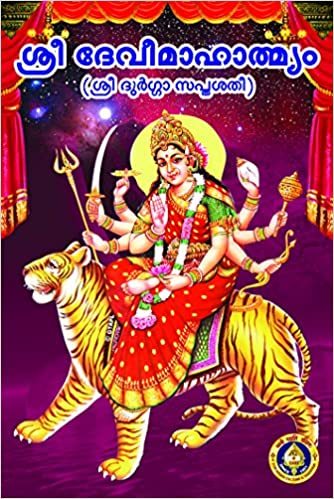
And so I am falling at your feet, For solving all my problems great. viswothpathi pranasa sthithi vihruthi pare devi gora marari thrasath thratham kulam na punarapi cha maha sankadeshwi diseshu avirbhooya purasthadithi chararana namath sarva geervana vargam durgam deveem prapadye sarana maha masesha apadan unmoolnaya Hey Goddess Durga, Who is engrossed in, Creation, upkeep and destruction of the universe, Hey Goddess, who is personification of light, The Gods and Devas appealed to you, “You have saved us mother, from the danger posed, By Great Rakshasas now by this war, And we pray that you should save Our progenies in future same as now” And thou acceded to their request, And so I am falling at your feet, For solving all my problems great. hanthum shumbham nishumbam tridasa gana nutham hemadolam himadri aarudaam vyuda darpan yudhi nihatha vathim dhoomra drik chanda mundane chamundakhyamdhadanam upasamitha maha raktha beejopasargam durgam devim prapadye saranamaha masesha apadan unmulanaya Acceding to the prayer of Gods, Thou came to the snowy mountains, In a golden swing, And killed the proud Asuras of Shumbha and Nishumba, After killing Dhoomraksha , Chanda and Munda, Thou were called and praised as Chamunda, And thou also killed the great scourge called Raktha Bheeja, And so I am falling at your feet, For solving all my problems great. brahmesa skanda narayana kiti narasimhendra shakthi swa bruthya kruthwa hathwa nisumbam jitha vibutha ganam trasitha sesha lokam eki bhooyada shumbham rana sirasi niha tyasithamatha gadgaam durgam devim prapadye sarana maha maseshapadan moolanaya Killed Thou Shumbha,
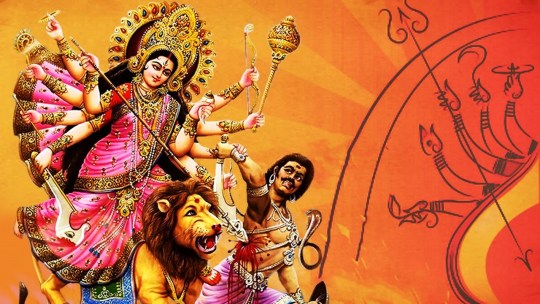
Who ruled over all devas, Making the Shakthi of Brahma, Skanda, Narayana, Narasimha, Varaha and Indra as thine assistants, And then merged all of them within you, And killed Nishumbha in an awesome war, And so I am falling at your feet, For solving all my problems great. uthpanna nandajethi swayam avani thale shumbamanyam nishumbham bramaryakya arunakhyam punarapi janani durgamakhyam nihanthum bheema sakambareethi truti tharipu gata raktha danthethi jaa thaam durgam devim prapadye saranamaha maseshapadan moolanaya You were born as daughter to King Nanda, In this holy earth, To kill the Rakshasas of Shumbha and Nishumba, And also born as a bee to kill the Asura called Aruna, And again born as the Holy Durga , To kill the asura called Durgama, You were famous as Bheema when you ate away asuras in fury, You were Known as Sakabhari when you grew food from your body , To the starving millions during a great famine, And also known as Raktha dantha, Because you ate the asuras Vipra Chitha, And so I am falling at your feet, For solving all my problems great. tri giunyaanam gunaanaam anusarana kala keeli naanavatharai tri lokya trana seelaam dhanuja kula vanee vahnee leela saleelaam deveem sachinma mayeem tham vitharitha vinamath sathree vargaaapavargaam durgam devim prapadye sarana maha masesha apath unmoolanaya You are all the three Gunaas rolled in to one, You play thine divine game in several forms, You take care of all the three worlds, As a child’s play thou decimate the asuras, Like the fury of cyclone in the forest, You are the personification of all that is good, To those who bow at your feet in humility, Thou grantest all that they want here in and after, And so I am falling at your feet, For solving all my problems great. simharoodam trinethraam kara thala vilasath sankha chakrasi ramyam bakthabeeshta pradathreem ripu madana kareem sarva lokaika vandhyam nana alankara yuktham sasi yutha makutam syamalangeem krusangeem durgam devim prapadhye saranamaha asesha apath unmoolanya She who rides on a lion, She who has three eyes, She who carries the conch and the wheel in pretty grace, She who fulfills requests of her devotees, She who kills her enemies, She who is venerated by all the worlds, She who is dressed in perfection,
Devi Mahatmyam Telugu Pdf Download
She who keeps the moon on her crown, She who is black in colour, And She who is tiny, I am falling at your feet, For solving all my problems great. trayaswa swamin ithi tri bhuvana janani prarthana twayya partha plyanth abhyarthanayam bhagawathi sisava knnvananya jananya tthubhyam syannamasyethya vanatha vibhdha aladhi veeksha visargam drgam devim prapadhye saranamaha asesha apath unmoolanya “There is no need to request thee Oh Durga, To protect and save us, For does the mother on whom they solely depend, Ever need such a request, And So our salutations to thee” So pray the Gods to thee, And so I am falling at your feet, For solving all my problems great. etham santha padanthu sthavam akhila vipa jjala thoolana labham hrinmoha dwantha bhanu prathima makhilam sankalpa kalpa dru kalpam dowrgam dowargathya goratha pathu hina kara pakhya mam ho gajendra soni panchasya desyam vpula bhayadha kalahitha tharkshya prabhavam Let this prayer to the Goddess Durga, Which is like a wind for cotton bundle of sins, Like a sun for pitch dark mind, Like the divine tree granting all wishes, Like the cool moon for the sweltering heat of poverty, Like a lion before the elephant herd of sins, And like the fearsome eagle before the king cobra, Save us from all dangers , And let all the devoted chant it always. Rajesh.V
Devi Mahatmyam Full Tamil With Meaning Pdf Converter
by Raghu Ranganathan & Akhila Ranganathan, Bhaskara Prakasha Ashram
The complete chanting of Durga Sapthasathi Puja Krama chanted by Sri Raghu Y Ranganathan and Smt. Akhila Ranganathan of Bhaskara Prakasha Ashram.
Devi Mahatmyam Tamil
The chanting is done in slow pace to be helpful to those learning Devi Mahatmyam to perform the full Durga Sapthasathi Puja Krama.
The text for this recording - Devi Mahatmya Parayana Krama Ebook - is available in Sanskrit,Telugu and Kannada at our Publications page.
This recording is dedicated to the lotus feet of our Guru Sri Sri Vimarshananda Nathendra Saraswathy and Durga Mata on the occasion of 2017 Navaratri celebration.
Devi Mahatmyam Mp3
Raghu Y Ranganathan and Akhila Ranganathan
Raghu Y Ranganathan and Akhila Ranganathan
Raghu Y Ranganathan and Akhila Ranganathan
Raghu Y Ranganathan and Akhila Ranganathan
Raghu Y Ranganathan and Akhila Ranganathan
Raghu Y Ranganathan and Akhila Ranganathan
Raghu Y Ranganathan and Akhila Ranganathan
Raghu Y Ranganathan and Akhila Ranganathan
Raghu Y Ranganathan and Akhila Ranganathan
Raghu Y Ranganathan and Akhila Ranganathan
Raghu Y Ranganathan and Akhila Ranganathan
Raghu Y Ranganathan and Akhila Ranganathan
Raghu Y Ranganathan and Akhila Ranganathan
Raghu Y Ranganathan and Akhila Ranganathan
Raghu Y Ranganathan and Akhila Ranganathan
Raghu Y Ranganathan and Akhila Ranganathan
Raghu Y Ranganathan and Akhila Ranganathan
Raghu Y Ranganathan and Akhila Ranganathan
Raghu Y Ranganathan and Akhila Ranganathan
Raghu Y Ranganathan and Akhila Ranganathan
Raghu Y Ranganathan and Akhila Ranganathan
Raghu Y Ranganathan and Akhila Ranganathan
Raghu Y Ranganathan and Akhila Ranganathan
Raghu Y Ranganathan and Akhila Ranganathan
Raghu Y Ranganathan and Akhila Ranganathan
Raghu Y Ranganathan and Akhila Ranganathan
Raghu Y Ranganathan and Akhila Ranganathan
Raghu Y Ranganathan and Akhila Ranganathan

0 notes
Text
Purify your soul with Ambe Tu hai Jagdambe Kaali Aarti - Times of India
New Post has been published on https://apzweb.com/purify-your-soul-with-ambe-tu-hai-jagdambe-kaali-aarti-times-of-india/
Purify your soul with Ambe Tu hai Jagdambe Kaali Aarti - Times of India

Chanting Ambe Tu Hai Jagdambe Kaali Aarti on a regular basis is the best way to please and receive the blessings of Maa Ambe. Ambe Mata is the Aadhya Shakti that is the supreme power. She is the manifestation of Maa Durga and is another name of Goddess Parvati. ‘Ambe tu hai jagadambe kaali’ is a Hindu hymn (aarti) dedicated to Goddess Parvati Devi, the spouse of Lord Shiva. She is also called Bahuchara Maa, Kalika Maa, Bhadrakali Maa, Maa Bhavani and a lot more names.
Ambe Tu hai Jagdambe Kaali Aarti in Hindi: अम्बे तू है जगदम्बे काली, जय दुर्गे खप्पर वाली, तेरे ही गुण गावें भारती, ओ मैया हम सब उतारे तेरी आरती।
तेरे भक्त जनो पर माता भीर पड़ी है भारी। दानव दल पर टूट पडो माँ करके सिंह सवारी॥ सौ-सौ सिहों से बलशाली, है अष्ट भुजाओं वाली, दुष्टों को तू ही ललकारती। ओ मैया हम सब उतारे तेरी आरती॥
माँ-बेटे का है इस जग मे बडा ही निर्मल नाता। पूत-कपूत सुने है पर ना माता सुनी कुमाता॥ सब पे करूणा दर्शाने वाली, अमृत बरसाने वाली, दुखियों के दुखडे निवारती। ओ मैया हम सब उतारे तेरी आरती॥
नहीं मांगते धन और दौलत, न चांदी न सोना। हम तो मांगें तेरे चरणों में छोटा सा कोना॥ सबकी बिगड़ी बनाने वाली, लाज बचाने वाली, सतियों के सत को सवांरती। ओ मैया हम सब उतारे तेरी आरती॥
Ambe Tu hai Jagdambe Kali Aarti in English:
Ambe Tu Hai Jagdambe Kali Jai Durga Khappar Wali l Tere Hi Gun Gayen Bharti,O Maiya Hum Sab Utare Teri Aarti ll
Tere Bhakt Jano Pe Mata Bheer Padi Hai Bhari l Danav Dal Par Toot Pado Maa Karke Sinh Savar ll Sou Sou Sinho Se Hai Balshali Hai Dus Bhujaon Wali l Dukhion Ke Dukhde Niwarti,O Maiya Hum Sab Utare Teri Aarti ll
Maan Bête Ka Hai Is Jug Main Bada Hi Nirmal Nata l Poot Kapoot Sune Hain Par Na Mata Suni Kumata ll Sub Pe Karuna Darsane Wali Amrit Barsane Wali l Dukhion Ke Dukhde Niwarti,O Maiya Hum Sab Utare Teri Aarti ll
Nahin Mangte Dhan Aur Daulat Na Chandi Na Sona l Hum To Mange Tere Man Main Ek Chhota Sa Kona ll Sub Ki Bigdi Banane Wali Laaj Bachane Wali l Sathiyon Ke Sat Ko Sanvarti,O Maiya Hum Sab Utare Teri Aarti ll
Ambe Tu Hai Jagdambe Kali Jai Durga Khappar Wali l Tere Hi Gun Gayen Bharti,O Maiya Hum Sab Utare Teri Aarti ll
Ambe Tu hai Jagdambe Kali Aarti Meaning:
अम्बे तू है जगदम्बे काली, जय दुर्गे खप्पर वाली, तेरे ही गुण गावें भारती, ओ मैया हम सब उतारे तेरी आरती।
O Mother, You are Mother of this entire world, Kaalee; Hail, O You Durgaa bearing skulls. Hindus sing about Your considerate mindset! O Mother, we all are singing Your aarti!
तेरे भक्त जनो पर माता भीर पड़ी है भारी। दानव दल पर टूट पडो माँ करके सिंह सवारी॥ सौ-सौ सिहों से बलशाली, है अष्ट भुजाओं वाली, दुष्टों को तू ही ललकारती। ओ मैया हम सब उतारे तेरी आरती॥
O Mother, a major team of evil spirits is disturbing Your lovers. O Mother, kindly mount Your lion and murder them! You are more grounded than several lions; You have eight hands ; You are the One Who challenges the shades of malice. O Mother, we all are singing Your aarti!
माँ-बेटे का है इस जग मे बडा ही निर्मल नाता। पूत-कपूत सुने है पर ना माता सुनी कुमाता॥ सब पे करूणा दर्शाने वाली, अमृत बरसाने वाली, दुखियों के दुखडे निवारती। ओ मैया हम सब उतारे तेरी आरती॥
In this world, the connection between Mother and youngster is dear; We have heard that a youngster can double-cross, however, we have never known about a mother’s double-crossing! O, You give leniency and downpour nectar on every one of us! You take care of the issues of miserable individuals. O Mother, we all are singing Your aarti!
नहीं मांगते धन और दौलत, न चांदी न सोना। हम तो मांगें तेरे चरणों में छोटा सा कोना॥ सबकी बिगड़ी बनाने वाली, लाज बचाने वाली, सतियों के सत को सवांरती। ओ मैया हम सब उतारे तेरी आरती॥
We are not requesting cash and riches, Neither silver nor gold.
We are just soliciting to have a piece from a corner-place inside Your heart. O, You are the One Who takes care of the issues of all, Who gets us far from dishonor, Who cleans the reality of genuine individuals. O Mother, we all are singing Your aarti!
Frequently Asked Questions:
How to chant Ambe Tu Hai Jagdambe Kaali Aarti? According to Hindu mythology, to get the most benefits from Ambe Tu hai Jagdambe Kaali Aarti, chant the aarti early morning after taking bath and in front of Goddess Kaali’s idol or picture. Try and understand the meaning of the aarti to maximize the benefits.
What are the benefits of chanting Ambe Tu Hai Jagdambe Kaali aarti? Regular chanting of Ambe Tu Hai Jagdambe Kaali Aarti gives peace of mind, keeps away from evil, and makes your life rich, prosperous, and healthy.
Who is the Aarti- Ambe Tu hai Jagdambe Kaali dedicated to? The Aarti Ambe Tu hai Jagdambe Kaali Aarti is dedicated to Maa Durga, Ambe Maata that is the mother in the Hindu religion.
What are the various incarnations of Maa Durga? There are 9 forms of Maa Durga (also synonymous with Gauri) or (Parvati): Shailaputri, Brahmacharini, Chandraghanta, Kushmanda, Skandamata, Katyayani, Kaalratri, Mahagauri, and Siddhidhatri.
Source link
#Ambe Tu hai Jagdambe Kaali Aarti#Ambe Tu hai Jagdambe Kaali Aarti in english#Ambe Tu hai Jagdambe Kaali Aarti in hindi#benefits of Ambe Tu hai Jagdambe Kaali Aarti#how to chant Ambe Tu hai Jagdambe Kaali Aarti#meaning of Ambe Tu hai Jagdambe Kaali Aarti#Astrology
0 notes
Photo

grab your copy now from kindle
USA - https://www.amazon.com/dp/B0761W5SSR
IN - https://www.amazon.in/dp/B0761W5SSR
UK - https://www.amazon.co.uk/dp/B0761W5SSR
CA - https://www.amazon.ca/dp/B0761W5SSR
DE - https://www.amazon.de/dp/B0761W5SSR
AU - https://www.amazon.com.au/dp/B0761W5SSR
Durga saptashlokee is a collection of seven important slokas from the sacred text Devi Maahaathmyam. The text Devi Maahatmyam praises the glories of mother Durgaa and elaborately narrates the great deeds of mother goddess. The text Durga Saptashlokee is a collection of the most important shlokas (mantras) from Durgaa patha for use in daily prayers and chants. Each of the seven shlokas praise the goddess Durgaa and pray to her for different fruits. All of these verses are found in different chapters of the Devi Maahaatmya. Each of these shlokas is a mantra which can also be chanted separately to please the mother and to attain a particular benefit, pray for protection, wealth, good fortune and the mother's (Ambaa's) grace. This hymn starts with a conversation between lord Shiva and Devi. One who chants this hymn with true devotion for goddess Durgaa shall be blessed with all fortunes of life and will also attain self realization by the grace of the goddess. In this book I will explain the meaning of those seven shlokas according to the commentaries of great shaakta scholars (devotees of mother goddess) like Bhaaskara raaya maakhin, Naagoji bhatta and other scholars of the shakta tradition
grab your copy now from kindle
USA - https://www.amazon.com/dp/B0761W5SSR
IN - https://www.amazon.in/dp/B0761W5SSR
UK - https://www.amazon.co.uk/dp/B0761W5SSR
CA - https://www.amazon.ca/dp/B0761W5SSR
DE - https://www.amazon.de/dp/B0761W5SSR
AU - https://www.amazon.com.au/dp/B0761W5SSR
1 note
·
View note
Link

Durga saptashlokee is a collection of seven important slokas from the sacred text Devi Maahaathmyam. The text Devi Maahatmyam praises the glories of mother Durgaa and elaborately narrates the great deeds of mother goddess. The text Durga Saptashlokee is a collection of the most important shlokas (mantras) from Durgaa patha for use in daily prayers and chants. Each of the seven shlokas praise the goddess Durgaa and pray to her for different fruits. All of these verses are found in different chapters of the Devi Maahaatmya. Each of these shlokas is a mantra which can also be chanted separately to please the mother and to attain a particular benefit, pray for protection, wealth, good fortune and the mother's (Ambaa's) grace. This hymn starts with a conversation between lord Shiva and Devi. One who chants this hymn with true devotion for goddess Durgaa shall be blessed with all fortunes of life and will also attain self realization by the grace of the goddess. In this book I will explain the meaning of those seven shlokas according to the commentaries of great shaakta scholars (devotees of mother goddess) like Bhaaskara raaya maakhin, Naagoji bhatta and other scholars of the shakta tradition
Click to buy durga saptashloki - print book
1 note
·
View note
Text
What should be done in times of Danger

The whole world is facing different problems today. Everyone is affected one way or the other by the calamities. What does our ancient wisdom say is what we will see in this post.
There is an old saying in Sanskrit in the form of a conversation
आपदि किं करणीयं स्मरणीयं चरणयुगलम्बायाः। तत्स्मरणं किं कुरुते ब्रह्मादीनपि किङ्करीकुरुते ॥
Aapadi Kim karaNiiyam ? SmaraNiiyam caraNayugaLamambaayaah. TatsmarNam Kim kurute? Bramhaadiinapi kinkariikurute.
Aapadi = During calamity Kim karaNiiyaani = what should be done? SmaraNiiyam =we should remember Ambaayaah caraNayugaLamam = the pair of feet of Mother Goddess ( durgaa , aadyaa shakti) Tat smaraNam Kim kurute = what will that remembering do? Bramhaadiinapi api kinkariikurute = it makes even the gods such as Brahma your servants
Here it is recommended to do remembrance of mother goddess because she is a goddess but she has motherhood, which makes it very easy for us children to connect with her, communicate, express and request her.
Acharya Shankara also celebrates her mother hood in the hymn devi aparadha kshamapana stotra
A hymn to Devi (feminine embodiment of ultimate power of the absolute god) for requesting her to forgive our mistakes and sins.
He says ‘kuputro jAyeta kvacidapi kumAtA na bhavati.’ – there can be bad sons and daughters but there can never be a bad mother.
Let us remember the qualities of mother, kind, protective, caring, loving, forgiving, who else other than the supreme god and his power be like this. Hence surrendering to the supreme in the form of mother goddess durga is easier and a lovely way to go in.
The benefit of surrendering to her holy feet and remembering her feet is described in the next verse of the shloka. That even brahma and other gods will become the devotee’s servants.
Meaning every god will fulfil your desire, every power will abide by your wish that’s because goddess durga is the combination of the powers of all gods (described in devi mahatmyam)
Surrendering to her with true devotion make all the gods and powers work on your favour.
In devi mahathmyam chapter 12 shloka 8 mother goddess durga says
उपसर्गानशेषांस्तु महामारीसमुद्भवान् ।
तथा त्रिविधमुत्पातं माहात्म्यं शमयेन्मम ॥ ८॥
upasargānaśeṣāṃstu mahāmārīsamudbhavān ।
tathā trividhamutpātaṃ māhātmyaṃ śamayenmama ॥ 8॥
Upasarga means a natural phenomenon supposed to forbode future evil, a disease, possession by an evil spirit; change occasioned by any disease; indication or symptom of death; a disease superinduced on another.
Ashesha means in its entirety, without any remains or even traces
mahAmArI – any mass killing disease and its effect, or anything which causes mass death , including natural calamities.
utpAta - phenomenon; any public calamity, as an eclipse, meteor, earthquake, whirlwind, a hurricane.
The utpātas are divided into three classes:
Divya - It denotes arising from heavenly sources. It is indicated by the abnormal condition of the planets and the stars, like eclipses and appearance of comets.
Āntarikṣa - It means springing from the atmospheric region. They are hurricanes, unusual clouds, fall of meteors, abnormal reddish appearances of the quarters and strange rainfall like blood red water.
Bhauma - It means appearing on the earth. It symbolizes earthquakes and unusual states of water reservoirs.
All these are controlled, destroyed by remembering her glory, reciting her glory.
To know more about the benefits of chanting the name of durga, the meaning of the name ‘durga’ etc.
You can get your copy of durgA nAma anushthAna available through your favourite online book stores.
https://books2read.com/links/ubl/mgZ1QX/
let us all pray for the welfare of the world.
namaschandikayai
0 notes